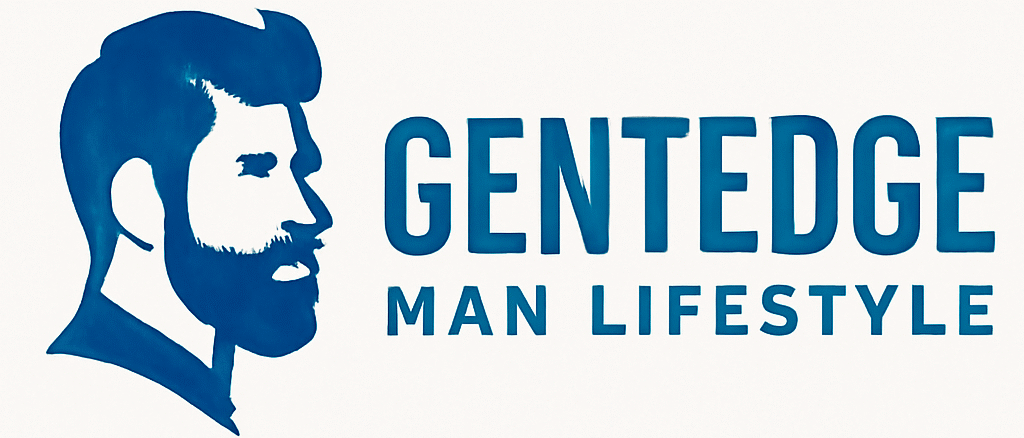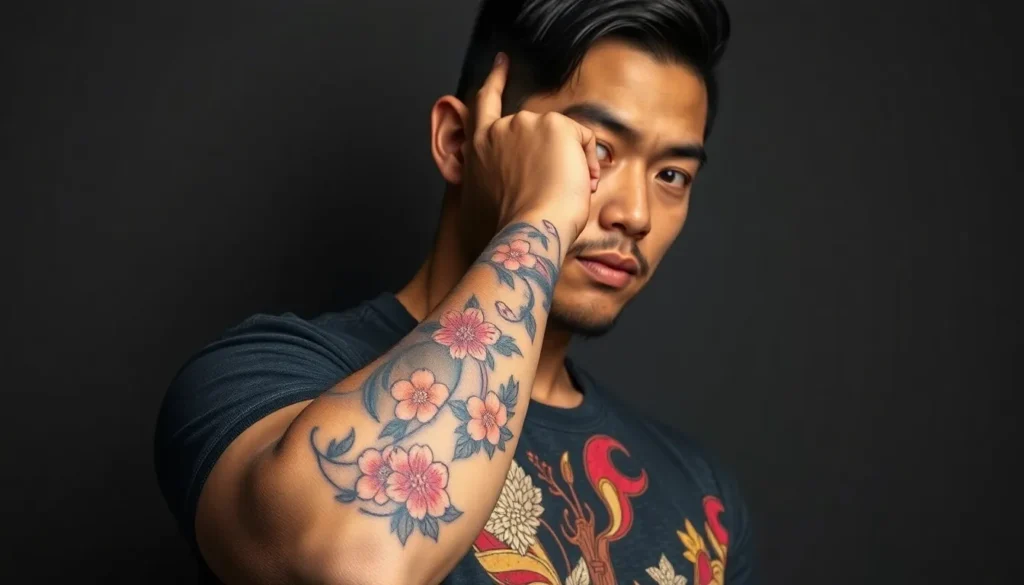Masculine meets elegance in the captivating industry of geisha tattoo designs for men. We’ve witnessed a remarkable surge in men choosing these intricate Japanese-inspired tattoos that blend traditional artistry with contemporary masculine aesthetics. The graceful beauty of a geisha can transform into a powerful statement piece that commands respect and admiration.
Men who choose geisha tattoos aren’t just selecting artwork – they’re embracing a rich cultural heritage that represents mystery, wisdom, and artistic mastery. These designs offer incredible versatility, from bold traditional Japanese styles to modern interpretations that incorporate personal elements and contemporary techniques.
Whether you’re drawn to the flowing kimono patterns, the delicate facial features, or the symbolic cherry blossoms that often accompany these designs, geisha tattoos provide endless creative possibilities. We’ll explore the most striking design variations, placement options, and cultural considerations that’ll help you create a tattoo that’s both respectful and uniquely yours.
Traditional Geisha Face Tattoo Designs for Men
Traditional geisha face tattoos capture the essence of classical Japanese beauty through intricate facial features and ceremonial makeup patterns. We’ve observed a important rise in men choosing these designs to honor the artistic traditions of geisha culture while creating bold masculine statements.
Classic Kabuki-Style Makeup Elements
Dramatic white foundation patterns form the cornerstone of traditional geisha face tattoos, creating striking contrast against natural skin tones. We recommend incorporating the distinctive white base makeup that extends from the hairline to the neck, often leaving deliberate unpainted areas around the eyes and mouth for artistic effect.
Bold red lip designs feature the classic small, bow-shaped mouth that geishas traditionally painted. These crimson accents typically appear smaller than natural lip lines, creating an elegant focal point that draws attention to the wearer’s facial structure.
Precise black eyeliner work includes the elongated eye shapes and dramatic lash lines characteristic of kabuki theater makeup. We’ve seen artists successfully incorporate thick black lines that extend beyond the natural eye shape, creating an otherworldly appearance that commands respect.
Strategic color placement involves careful consideration of where traditional makeup elements will translate effectively as permanent tattoos. The contrast between stark white base areas and vibrant accent colors creates visual depth that works exceptionally well in larger tattoo compositions.
Ornate Hair Ornament Details
Elaborate kanzashi flowers serve as the most recognizable hair accessories in geisha tattoo designs, featuring intricate petal work and delicate stems. We often see these floral elements incorporated as cascading designs that flow naturally with the hair’s movement in the tattoo composition.
Decorative combs and pins add authentic detail to traditional geisha face tattoos, showcasing the craftsmanship of Japanese hair accessories. These metallic elements typically feature gold or silver ink work that catches light beautifully when properly executed by skilled tattoo artists.
Seasonal motif integration includes cherry blossoms for spring, maple leaves for autumn, and chrysanthemums for winter themes. We’ve found that incorporating these seasonal elements helps create more personalized designs that reflect the wearer’s connection to exact times of year or personal meanings.
Dangling ornament chains feature small bells, tassels, or decorative cords that traditionally hang from larger hair pieces. These flowing elements add movement and grace to static tattoo designs, creating the illusion of motion even in permanent artwork.
Symbolic Fan and Umbrella Additions
Traditional folding fans represent elegance and social status in geisha culture, making them powerful symbolic additions to face tattoo designs. We recommend positioning these fans to frame the geisha’s face or incorporate them as background elements that enhance the overall composition without overwhelming the facial features.
Decorative parasol elements include the ornate papers and bamboo framework that characterize traditional Japanese umbrellas. These circular shapes work exceptionally well as framing devices around geisha faces, creating natural boundaries that help focus attention on the central portrait.
Cherry blossom fan patterns combine two iconic Japanese symbols into cohesive design elements that enhance cultural authenticity. We’ve observed how these floral fan motifs can bridge the gap between traditional imagery and contemporary tattoo aesthetics, appealing to men seeking culturally respectful designs.
Geometric umbrella spokes provide structural elements that can extend beyond the main tattoo design, creating opportunities for larger compositions or connecting pieces. These linear elements help balance the soft curves of geisha facial features with sharp, masculine geometric patterns that appeal to male clientele.
Modern Geisha Portrait Tattoos With Masculine Touches
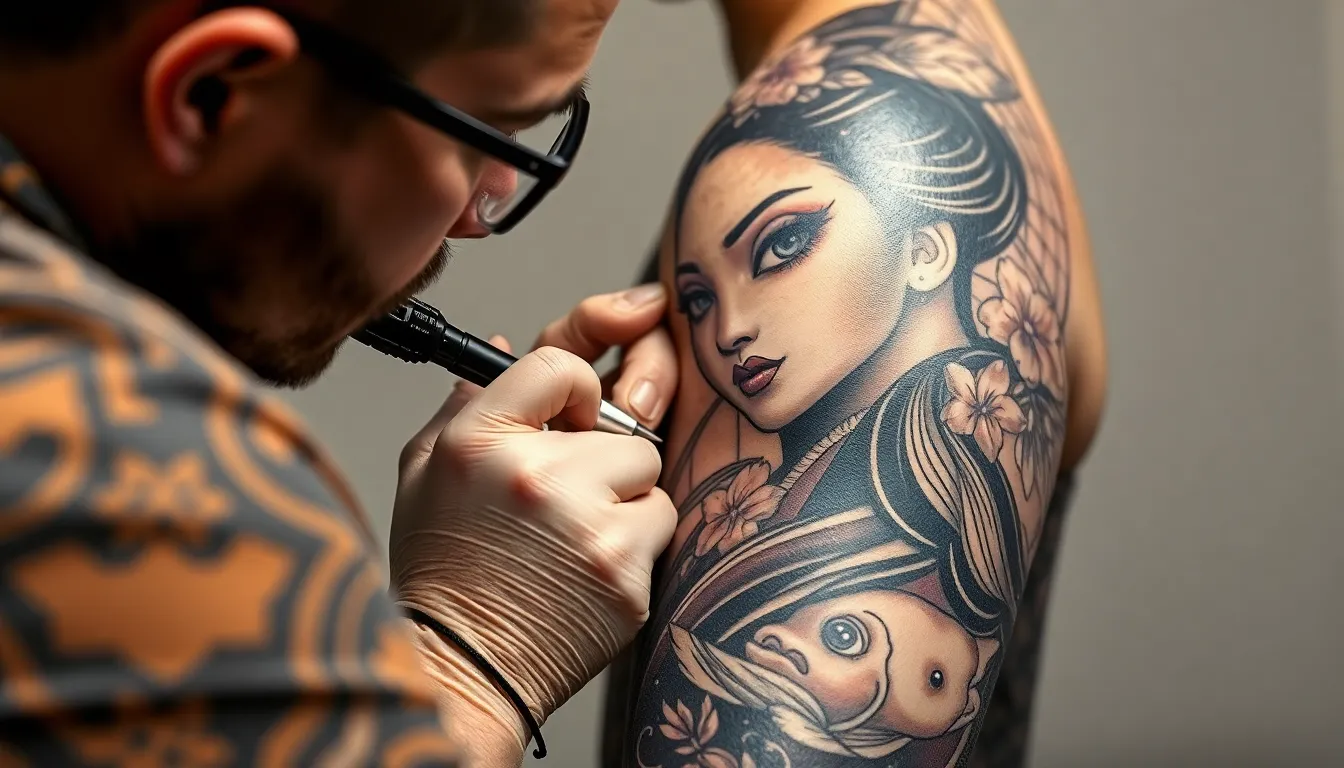
Contemporary male artists are transforming traditional geisha imagery into powerful masculine statements that honor cultural heritage while embracing modern aesthetics. These designs maintain the elegant essence of geisha beauty but incorporate stronger visual elements that resonate with male clientele.
Bold Black and Gray Shading Techniques
Dramatic contrast becomes the foundation of masculine geisha portraits through sophisticated black and gray shading methods. Artists create depth and intensity by emphasizing facial contours with bold shadows that enhance the geisha’s features without losing delicate details. Textural elements emerge through strategic shading patterns that add dimension to kimono fabric and hair ornaments.
Realistic depth develops when artists layer multiple gray tones to create three dimensional effects across the portrait. Shading techniques highlight cheekbones and jawlines while maintaining the soft beauty traditionally associated with geisha imagery. Visual impact increases significantly when darker tones frame lighter areas, creating striking focal points that draw attention to key features.
Timeless appeal results from monochromatic color schemes that avoid trends while emphasizing artistic skill and technical precision.
Incorporating Geometric Background Patterns
Angular elements create ever-changing contrast when paired with the organic curves of traditional geisha portraits. Artists integrate hexagonal patterns, triangular formations, and repetitive line work to establish modern backgrounds that frame the central figure. Structural balance emerges from combining soft facial features with sharp geometric shapes that add contemporary flair.
Abstract integration allows geometric patterns to flow seamlessly around the geisha figure without overwhelming the primary imagery. These backgrounds often feature intersecting lines or tessellated shapes that create visual interest while maintaining cultural respect. Modern aesthetics develop through the strategic placement of geometric elements that enhance rather than compete with traditional motifs.
Masculine appeal increases when geometric patterns provide structured frameworks that complement the flowing nature of kimono designs and hair arrangements.
Adding Contemporary Artistic Flair
Personal storytelling becomes possible when artists incorporate additional symbolic elements like cherry blossoms, koi fish, or ceremonial fans into geisha portraits. These additions create unique narratives that reflect individual preferences while maintaining cultural authenticity. Artistic freedom allows for creative interpretations that blend traditional imagery with modern techniques.
Minimalist approaches appeal to men seeking clean, stylized designs that focus on essential elements without excessive ornamentation. Some artists create collage effects or introduce selective color splashes against predominantly monochrome backgrounds. Individual expression emerges through custom additions that make each tattoo distinctive while respecting geisha cultural significance.
Contemporary techniques include watercolor effects, sketch style elements, or mixed media appearances that give traditional subjects modern artistic treatments.
Full Sleeve Geisha Tattoo Concepts for Men
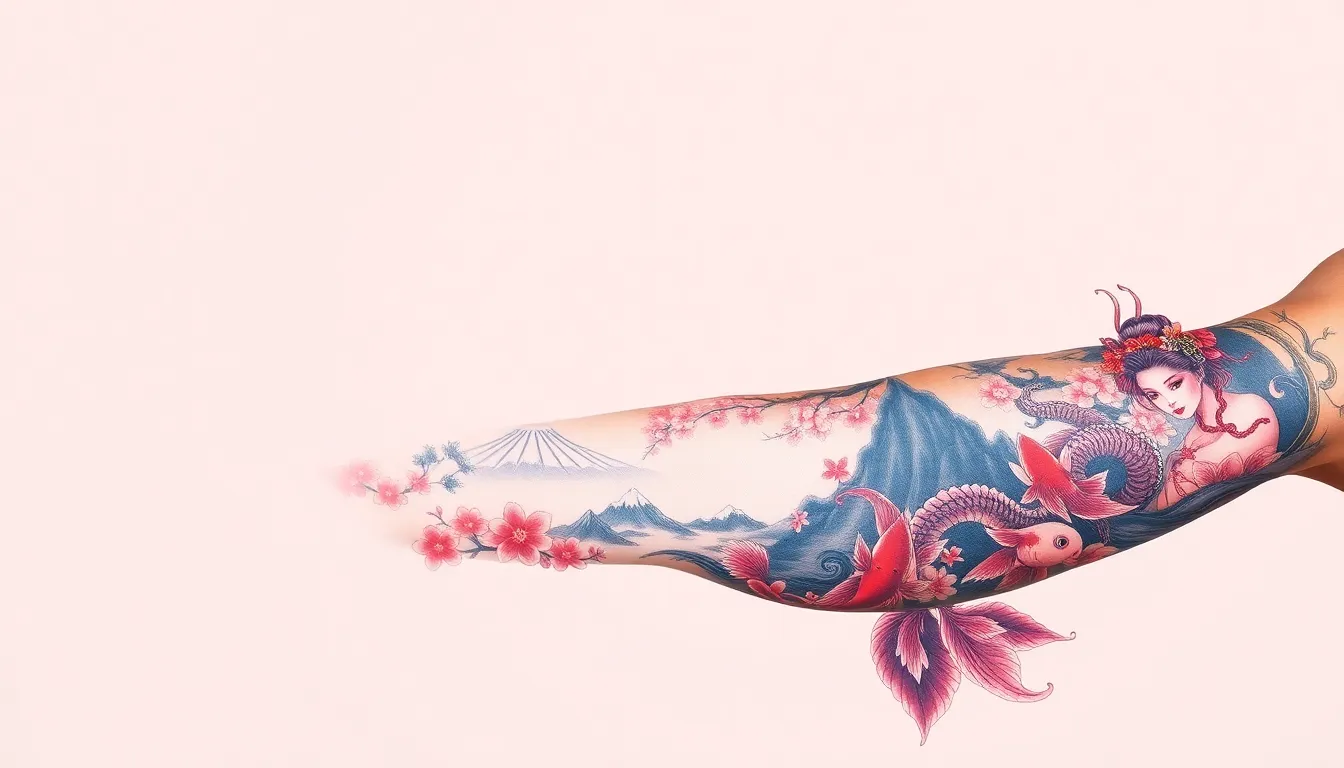
Full sleeve geisha tattoos offer the perfect canvas for showcasing intricate Japanese artistry across your entire arm. We’ve seen these designs transform traditional feminine imagery into powerful masculine statements that honor cultural heritage while making bold artistic choices.
Japanese Industry Integration
Integrating traditional Japanese landscapes creates a stunning backdrop that grounds your geisha tattoo in authentic cultural context. Mountains, temples, and flowing water elements provide depth and visual balance while showcasing the rich heritage of Japan.
Traditional elements like Mount Fuji silhouettes add iconic symbolism to your sleeve design. We recommend incorporating these industry features as supporting imagery that frames your geisha portrait without overwhelming the central figure.
Flowing water patterns and architectural details like pagoda rooftops create natural transitions between different sections of your sleeve. These background elements help establish the cultural setting while providing opportunities for seamless design flow from shoulder to wrist.
Cherry Blossom and Koi Fish Combinations
Cherry blossoms represent the transient beauty of life and add delicate contrast to bold geisha portraits. We often see these sakura elements scattered throughout sleeve designs to create movement and seasonal symbolism.
Koi fish bring powerful symbolism of determination and good fortune to your geisha tattoo composition. These graceful creatures naturally complement the flowing lines of traditional geisha robes while adding vibrant color opportunities.
Combining both elements creates a ever-changing narrative within your sleeve design. We suggest positioning koi fish swimming through falling cherry blossom petals to represent life’s journey and the pursuit of beauty even though challenges.
Color placement becomes crucial when incorporating these natural elements alongside your geisha portrait. Traditional pink and white sakura blooms contrast beautifully with the rich oranges and reds of koi fish scales.
Dragon and Phoenix Mythical Elements
Dragons symbolize wisdom and protection while adding masculine power to feminine geisha imagery. We’ve observed how these mythical creatures create perfect balance between grace and strength in full sleeve compositions.
Phoenix imagery represents rebirth and immortality, making it an ideal companion for geisha portraits that embody transformation. These legendary birds add vertical movement and dramatic flair to your sleeve design.
Positioning these mythical elements requires careful consideration of visual hierarchy and cultural respect. We recommend using dragons as wraparound elements that flow naturally with your arm’s contours while phoenixes can soar above or behind your geisha figure.
Combining both creatures creates a powerful yin and yang ever-changing that enhances your tattoo’s symbolic depth. Traditional Japanese folklore often depicts these beings as complementary forces, making them natural partners in comprehensive sleeve designs.
Neo-Traditional Geisha Tattoo Styles
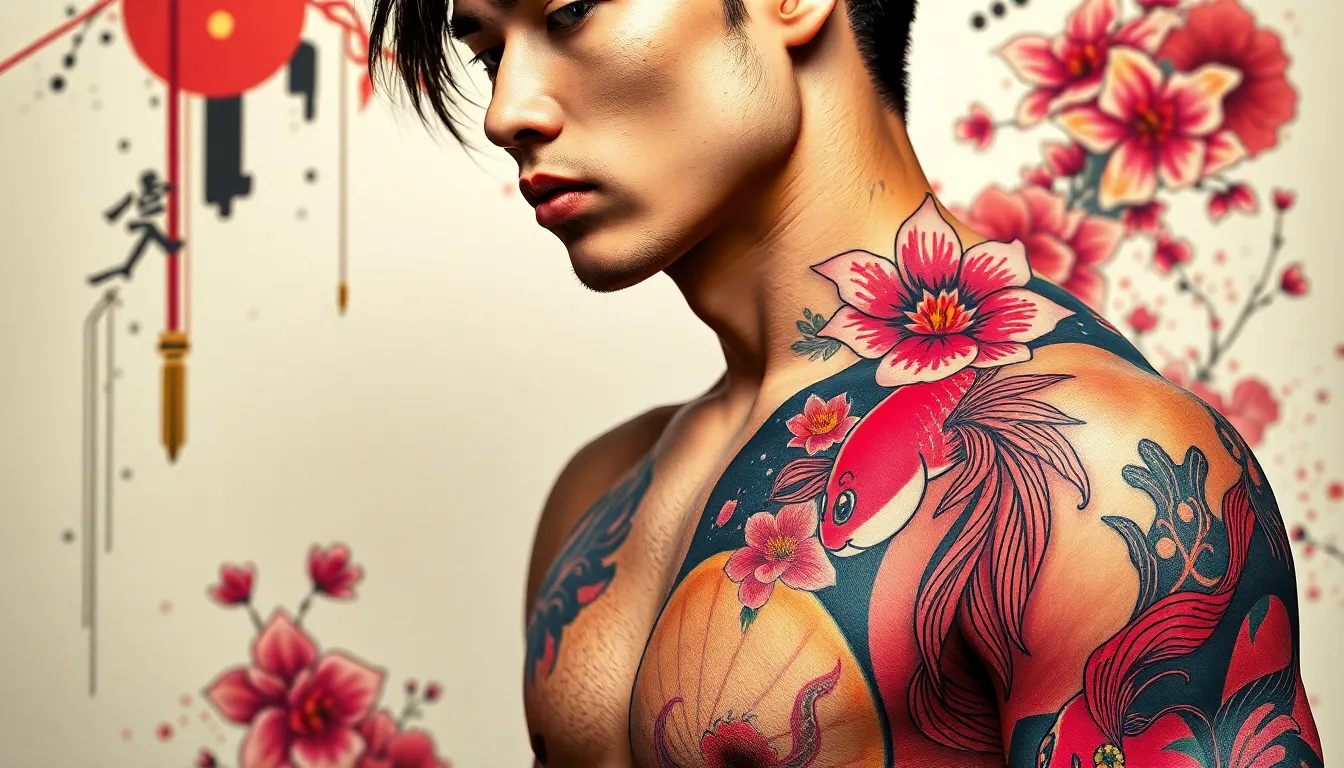
Neo-traditional geisha tattoos for men represent a compelling evolution of classic Japanese imagery, emphasizing bold outlines and rich shading that creates dramatic depth and visual impact. We’re seeing this style maintain respectful cultural origins while providing extensive room for artistic creativity and personalization.
Vibrant Color Palette Choices
Deep reds dominate the color schemes in neo-traditional geisha tattoos, creating striking contrasts that highlight kimono fabrics and ceremonial makeup elements. Bright pinks enhance the delicate features of cherry blossoms and floral hair accessories, while rich blues provide depth to background elements and flowing water motifs. Gold accents illuminate hair ornaments like kanzashi flowers and decorative combs, adding luxury and authenticity to the overall design.
These saturated colors create ever-changing visual contrast against skin tones, making each tattoo element pop with intensity and vibrancy. Artists often layer these hues strategically to emphasize the geisha’s graceful features while maintaining the bold aesthetic that appeals to male clientele. Color placement becomes crucial in neo-traditional work, with warmer tones drawing attention to focal points and cooler shades providing supporting depth.
Enhanced Artistic Interpretation
Artists integrate additional Japanese cultural motifs like cherry blossoms, folding fans, and koi fish to enrich the narrative symbolism beyond traditional geisha portraiture. Modern abstract backgrounds blend seamlessly with classic imagery, creating unique artistic expressions that honor heritage while embracing contemporary aesthetics. Exaggerated facial features become signature elements in neo-traditional interpretations, with stylized makeup patterns and intricate kimono designs adding layers of visual complexity.
Geometric patterns often frame the central geisha figure, providing angular contrast to the organic curves of traditional Japanese art. These artistic choices allow for individual expression while maintaining cultural respect and authenticity. Symbolic elements like dragons or phoenixes may appear alongside the geisha, representing wisdom and protection while improving the tattoo’s masculine appeal.
Western Tattoo Art Fusion
Bold lines characteristic of Western traditional tattooing combine effectively with Japanese geisha imagery, creating cross-cultural artistic fusion that appeals to modern tattoo enthusiasts worldwide. Heavy black outlines provide structure and definition that wasn’t typically found in classical Japanese tattoo work, giving these pieces a contemporary edge. Shading techniques borrowed from Western neo-traditional styles add dimensional depth to facial features and fabric textures.
This fusion approach honors the historic significance of geisha culture while adapting to Western tattoo conventions and preferences. Artists blend Eastern symbolism with Western technical execution, resulting in tattoos that speak to global audiences seeking meaningful art with vibrant visual impact. The combination creates pieces that feel both authentically Japanese and distinctly modern, perfect for men wanting cultural appreciation without traditional constraints.
Placement Ideas for Geisha Tattoos on Men
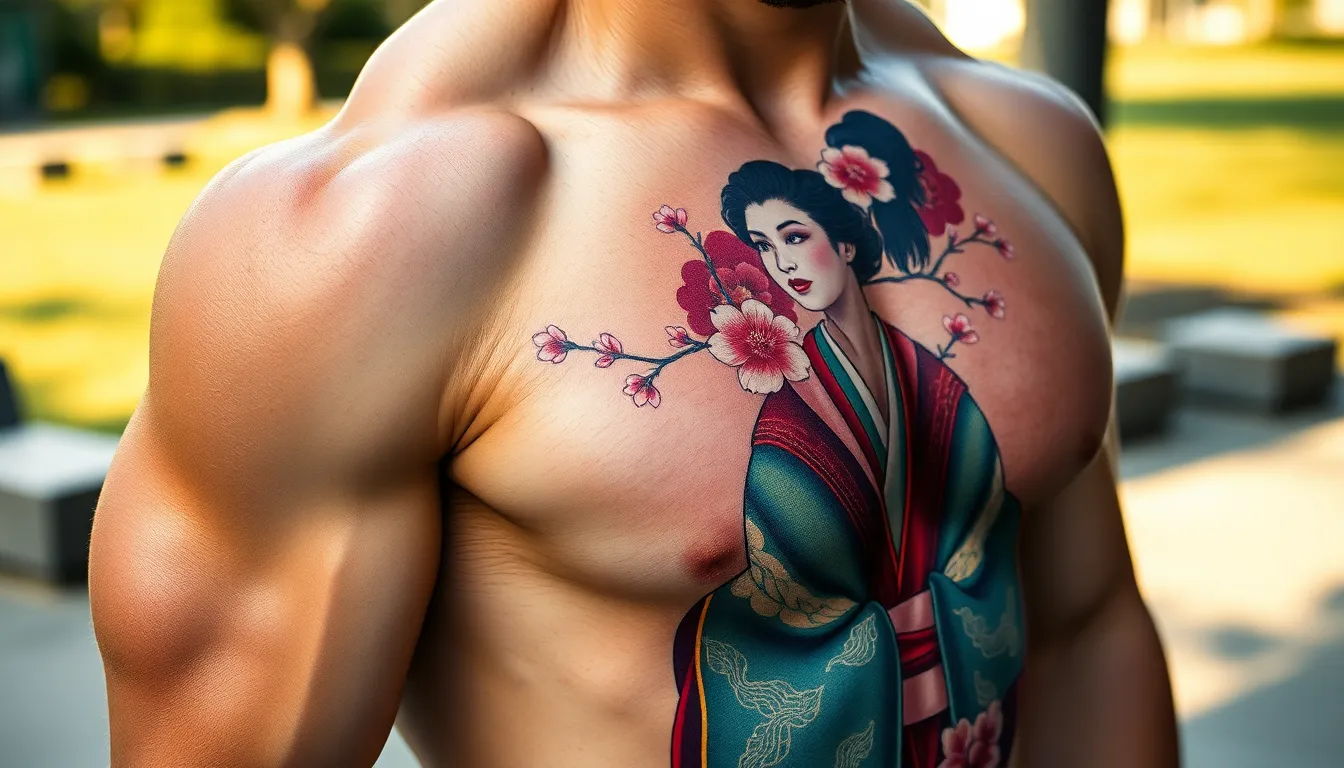
Selecting the perfect placement for your geisha tattoo determines both its visual impact and personal significance. We’ve identified three primary locations that offer optimal canvas space and aesthetic appeal for masculine geisha designs.
Upper Arm and Shoulder Positioning
Upper arm placements provide the most versatile canvas for geisha tattoo designs, offering excellent visibility control and natural body contouring. This location accommodates detailed artwork while allowing you to showcase or conceal the design based on clothing choices. The shoulder’s natural curves enhance the flowing lines of traditional geisha garments, creating a harmonious integration with your body’s anatomy.
Shoulder positioning works exceptionally well with accompanying elements like cherry blossoms, decorative fans, and traditional Japanese patterns that can extend down the arm. Artists often use the deltoid muscle’s rounded surface to emphasize the geisha’s elegant posture and flowing kimono sleeves. The upper arm’s muscle definition adds depth to shading techniques, particularly in black and gray designs that create dramatic masculine portraits.
Back Piece Design Considerations
Back pieces offer the largest available canvas for comprehensive geisha tattoo designs, making them ideal for elaborate storytelling compositions. This placement suits men seeking prominent artwork that incorporates multiple traditional Japanese elements alongside the central geisha figure. Full back designs can include landscapes like Mount Fuji, flowing water scenes, and mythical creatures such as dragons or koi fish.
Artists frequently use the back’s expansive surface to create layered compositions where the geisha becomes part of a larger cultural narrative. The spine serves as a natural dividing line for symmetrical designs, while the shoulder blades provide elevated focal points for detailed facial features. Back placements also accommodate both vertical and horizontal design orientations, allowing for creative flexibility in composition and storytelling elements.
Chest and Ribcage Placement Options
Chest positioning creates an intimate and powerful statement piece that follows your body’s natural contours and breathing patterns. This location works particularly well for vertical geisha designs where flowing kimono patterns can extend from the collarbone to the lower chest area. The pectoral muscles provide natural depth for shading techniques that enhance facial features and fabric textures.
Ribcage placements offer a more private and selective reveal option while providing excellent surface area for detailed artwork. The ribs’ natural curves complement the organic lines of traditional geisha poses and garment flow. Side chest designs can incorporate wraparound elements that extend to the back or arm, creating a cohesive larger piece. Both chest and ribcage locations allow for personal storytelling through additional elements like cherry blossoms, fans, or geometric patterns that enhance the overall cultural authenticity.
Cultural Significance and Respectful Representation
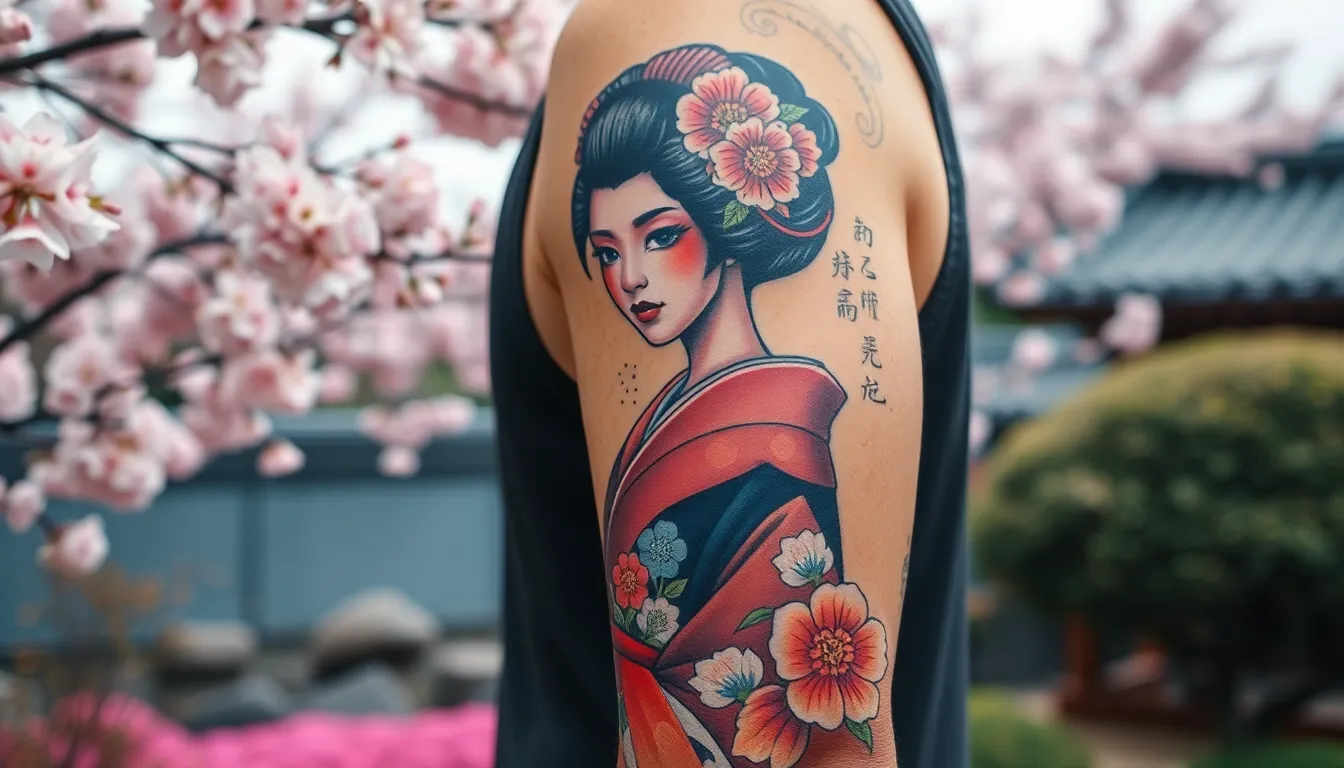
When choosing geisha tattoo designs for men, we must recognize that these images carry deep cultural weight and represent centuries of Japanese artistic tradition. Respectful representation becomes essential as we honor the profound heritage behind these meaningful designs.
Understanding Geisha History and Traditions
Geishas represent professional female entertainers trained in traditional Japanese arts who’ve preserved classical music, dance, and social etiquette for generations. These cultural institutions embody beauty, grace, artistic mastery, and refined artistry that Japanese society has cherished throughout history. Their iconic attire, hairstyles, and makeup carry symbolic meaning that extends far beyond aesthetic appeal.
Traditional Japanese tattoo style Irezumi often portrays the full spectacle of the geisha’s regalia, capturing every intricate detail of their cultural significance. Neo-traditional styles offer more creative interpretations that focus on serene expressions and graceful movements while maintaining cultural authenticity. Each element within the design connects to exact traditions, from ceremonial makeup patterns to seasonal motifs that reflect Japan’s deep connection to nature.
Understanding this rich background helps us appreciate why geisha tattoos aren’t merely decorative pieces but meaningful representations of Japanese cultural heritage. We carry a piece of this profound tradition when we choose these designs, making cultural sensitivity paramount to the entire process.
Avoiding Stereotypical or Offensive Elements
Stereotypical or fetishized depictions that reduce geishas to exotic or sexualized images can be deeply offensive and culturally insensitive. We must avoid trivializing their role and significance through misappropriation that disrespects their cultural importance. Respectful geisha tattoos should celebrate the artistry and tradition rather than exploit or objectify these cultural figures.
Each component within the tattoo design holds exact symbolic meaning that deserves proper representation. Floral elements correspond to particular virtues or seasons, while color choices communicate different aspects of Japanese philosophy and aesthetics. Thoughtful geisha warrior tattoos might communicate strength and bravery when designed with proper cultural understanding.
Modern interpretations can incorporate contemporary elements while maintaining respect for the original cultural context. We should focus on honoring the qualities geishas represent rather than creating designs that perpetuate harmful stereotypes or reduce their significance to mere decoration.
Working With Culturally Aware Tattoo Artists
Collaborating with tattoo artists who specialize in Japanese tattoo art and understand cultural nuances ensures authentic and respectful geisha designs. Experienced artists guide the design process to guarantee accurate symbolic representation while honoring the tradition behind each element. They possess the knowledge needed to create meaningful tattoos that celebrate rather than appropriate Japanese culture.
Research and consultation become essential before committing to any geisha tattoo design to ensure it remains a respectful homage. Artists familiar with Japanese tattooing traditions can explain the significance of different design elements and help create compositions that maintain cultural integrity. Their expertise prevents us from inadvertently including offensive or inappropriate elements in our designs.
Skilled tattoo artists also understand how to blend traditional Japanese imagery with modern masculine aesthetics while preserving cultural respect. They can recommend appropriate placement, sizing, and complementary elements that enhance the overall design without compromising its cultural significance.
Choosing the Right Tattoo Artist for Your Geisha Design
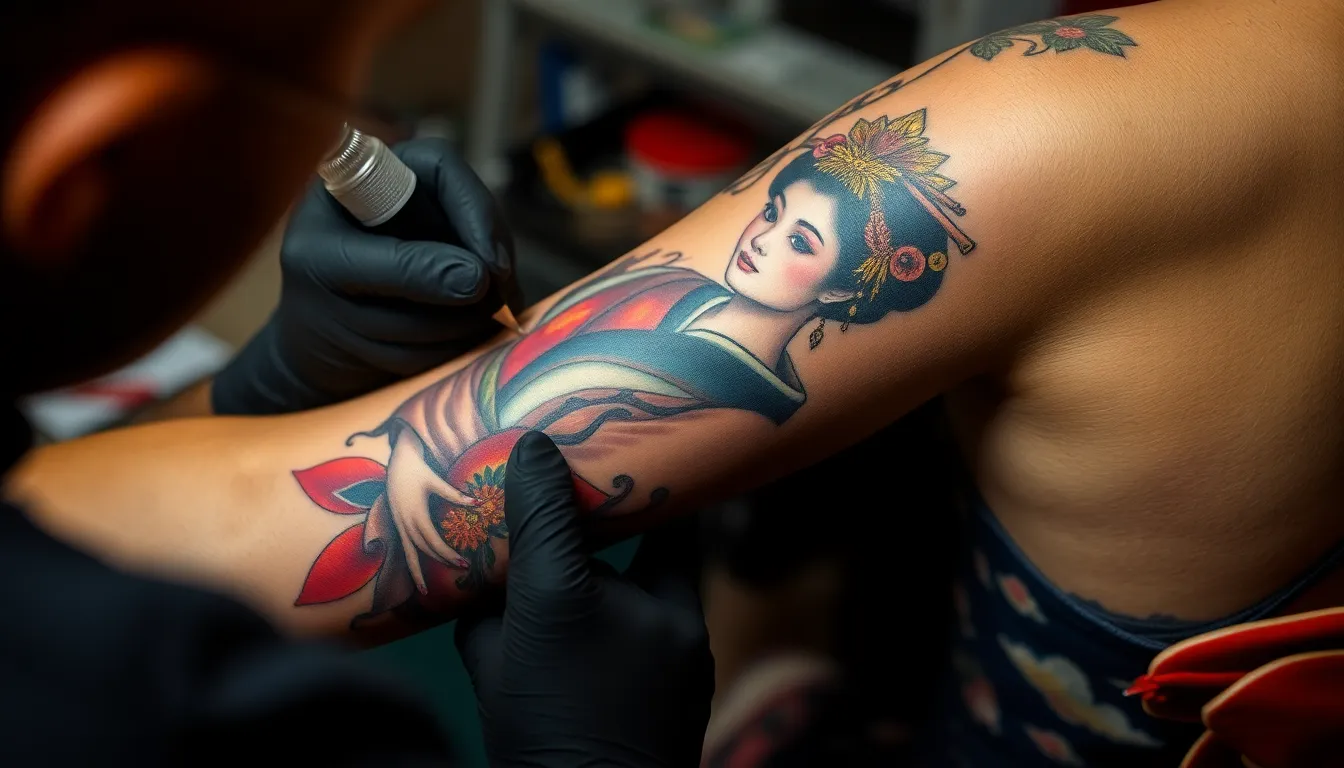
Selecting the right artist makes the difference between a meaningful tribute and a cultural misrepresentation. Our geisha tattoo deserves an artist who understands both technical excellence and cultural significance.
Researching Japanese Art Specialists
Japanese tattoo artistry demands specialized knowledge that goes beyond general tattooing skills. Artists experienced in Japanese-style tattoos better understand cultural symbols, traditional motifs, and technical requirements for recreating delicate lines and vibrant colors characteristic of geisha designs.
We should look for artists who’ve dedicated time to studying traditional Japanese art forms. Many specialists have traveled to Japan or trained under masters of the create. Check if they’ve worked extensively with irezumi techniques or traditional Japanese tattooing methods.
Search for artists who regularly create work featuring human figures in traditional Japanese contexts. Their understanding of proportions, clothing details, and ceremonial elements will directly impact our tattoo’s authenticity and visual appeal.
Portfolio Evaluation Tips
High-quality Japanese tattoo art requires mastery of human figures, traditional costumes, and accompanying cultural elements like cherry blossoms or fans. We need to examine previous work for attention to detail, color accuracy, and smooth shading techniques.
Look for portfolios that demonstrate versatility in adapting traditional motifs to unique client visions. Artists should show consistency in their line work and ability to capture the subtle expressions that make geisha imagery so compelling.
Evaluate how well they handle flowing fabric textures and intricate hair ornaments. These details separate amateur work from professional Japanese tattoo artistry. Pay attention to how they integrate background elements and maintain proper proportions across larger pieces.
Review their color work specifically, as traditional geisha tattoos often feature rich reds, deep blues, and subtle skin tones. Poor color application or fading can ruin the delicate beauty these designs require.
Communication and Design Collaboration
Effective partnership with our chosen artist ensures both visual excellence and cultural respect. We should discuss our ideas, preferred symbolism, and placement options during initial consultations.
Skilled artists will guide us toward design choices that work best with our body’s contours while suggesting customizations that make the tattoo uniquely ours. They’ll help us understand which elements translate well to different body areas and how size affects detail visibility.
Collaborate on incorporating personal meaning while maintaining cultural authenticity. Our artist should explain the significance of various elements we’re considering and help us avoid potentially offensive combinations or misrepresentations.
Establish clear expectations about timeline, pricing, and revision processes. Complex geisha designs often require multiple sessions, and we need artists who’ll maintain quality throughout the entire process rather than rushing to completion.
Aftercare and Maintenance for Detailed Geisha Tattoos
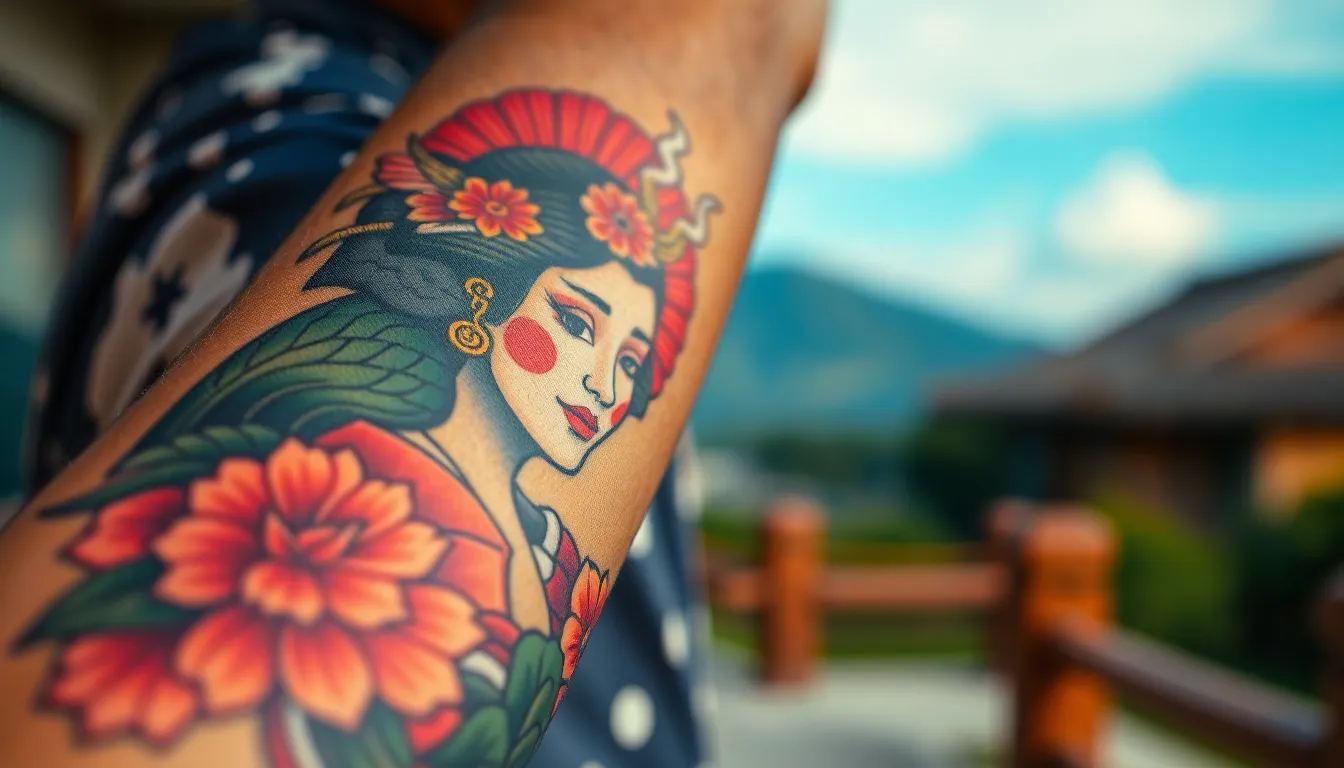
Your geisha tattoo’s intricate details and vibrant colors require specialized care to maintain their stunning appearance. We’ll guide you through essential aftercare practices and maintenance strategies that protect your investment for years to come.
Protecting Intricate Line Work
Geisha tattoos contain fine lines and detailed shading that demand gentle handling during the healing process. Clean your tattoo twice daily with mild, fragrance-free soap and lukewarm water to remove bacteria without disturbing delicate artwork. Avoid picking, scratching, or allowing blood and lymph to harden on the surface, as these actions can permanently damage intricate line work.
Loose-fitting clothing prevents friction and irritation that could blur fine details during healing. Pat the area dry with a clean towel rather than rubbing, which protects the delicate skin surface. Apply a thin layer of tattoo-exact aftercare ointment 2-3 times daily for approximately two weeks, focusing on areas with the most detailed work.
Monitor your tattoo for signs of excessive scabbing or color loss in fine line areas. Contact your artist immediately if you notice any irregularities that could affect the precision of your geisha design’s facial features or ornamental details.
Color Preservation Techniques
Sun exposure poses the greatest threat to your geisha tattoo’s vibrant colors and detailed shading. Keep your fresh tattoo completely covered from direct sunlight during the initial 4-week healing period to prevent premature fading. Once healed, apply broad-spectrum sunscreen with SPF 30 or higher whenever exposing your tattoo to UV rays.
Daily moisturizing maintains skin elasticity and prevents color dulling after the initial healing phase. Choose unscented, tattoo-safe moisturizers that won’t clog pores or irritate sensitive skin around detailed artwork. Regular hydration keeps the skin flexible and prevents cracking that could damage color saturation.
Avoid soaking your tattoo in baths, swimming pools, or hot tubs until completely healed. Prolonged water exposure can cause ink loss and affect the vibrancy of your geisha design’s traditional colors like deep reds, blacks, and gold accents.
Long-Term Touch-Up Considerations
Fine details and vibrant colors in geisha tattoos may require periodic maintenance to preserve their original impact. Schedule touch-up consultations with your original artist every 3-5 years to assess color saturation and line clarity. Early intervention prevents minor fading from becoming major restoration projects.
Consider seasonal timing for touch-up sessions, as proper aftercare requires sun protection during healing. Spring scheduling allows for optimal healing before summer sun exposure, while fall appointments provide healing time before holiday celebrations.
Document your tattoo’s appearance with high-quality photos immediately after healing to track changes over time. These reference images help your artist identify exact areas needing attention during touch-up consultations. Budget for maintenance costs when planning your geisha tattoo, as complex designs with intricate details typically require more frequent touch-ups than simpler artwork.
Conclusion
We’ve explored how geisha tattoo designs offer men a unique opportunity to embrace powerful artistic expression while honoring centuries-old Japanese traditions. These tattoos represent far more than aesthetic choices—they’re meaningful statements that blend cultural respect with personal storytelling.
The key to success lies in partnering with skilled artists who understand both the technical demands and cultural significance of these designs. Through proper research collaboration and respectful representation we can create tattoos that celebrate geisha heritage without exploitation.
With dedicated aftercare and maintenance your geisha tattoo will remain a striking testament to this beautiful art form for years to come. We encourage you to approach this journey thoughtfully and work with professionals who share your commitment to cultural authenticity and artistic excellence.
Frequently Asked Questions
What makes geisha tattoos suitable for men?
Geisha tattoos blend traditional Japanese artistry with modern masculine aesthetics, creating striking artwork that embodies mystery, wisdom, and artistic mastery. Contemporary artists transform feminine imagery into powerful masculine statements using bold black and gray shading, geometric patterns, and personal storytelling elements while maintaining cultural respect and authenticity.
Where should men place geisha tattoos for optimal visual impact?
Popular placement options include full sleeves, back pieces, chest panels, and shoulder areas. These locations provide adequate space for intricate details and allow the design to flow naturally with body contours. The placement should consider both visual impact and personal significance while accommodating the tattoo’s size and complexity.
How can I ensure my geisha tattoo is culturally respectful?
Research the deep heritage behind geisha culture and avoid stereotypical elements. Collaborate with culturally aware tattoo artists who understand traditional Japanese imagery. Focus on celebrating geisha traditions as professional entertainers and artists rather than exploiting cultural symbols. Thoughtful design choices honor rather than appropriate the culture.
What styles work best for masculine geisha tattoos?
Neo-traditional styles with bold outlines and rich shading work exceptionally well. Geometric background patterns, traditional Japanese landscapes, and mythical elements enhance symbolic depth. The fusion of Western tattoo techniques with Japanese imagery creates contemporary appeal while maintaining cultural authenticity and masculine aesthetic balance.
How do I choose the right artist for a geisha tattoo?
Select specialists experienced in Japanese-style tattoos who understand both technical excellence and cultural significance. Evaluate portfolios for attention to detail, color accuracy, and ability to handle traditional motifs. Ensure effective communication about personal meanings while maintaining cultural authenticity and clear expectations regarding timelines and pricing.
What special aftercare do geisha tattoos require?
Geisha tattoos need specialized care to preserve intricate details and vibrant colors. Practice gentle cleaning, avoid sun exposure, and use tattoo-safe moisturizers. Monitor for signs of fading and schedule periodic touch-ups with your original artist to maintain the tattoo’s visual impact and cultural authenticity over time.
Can traditional geisha elements be modified for modern appeal?
Yes, traditional elements like kanzashi flowers, decorative combs, folding fans, and kabuki makeup can be stylized with contemporary techniques. Geometric elements balance soft curves with sharp lines, while personal storytelling additions like cherry blossoms and koi fish create unique narratives that reflect individual preferences.
How long does a complex geisha tattoo take to complete?
Complex geisha tattoos, especially full sleeves or back pieces, typically require multiple sessions spanning several months. The timeline depends on design complexity, size, color work, and individual healing rates. Discuss realistic timeframes and session scheduling with your artist during the consultation process for proper planning.
